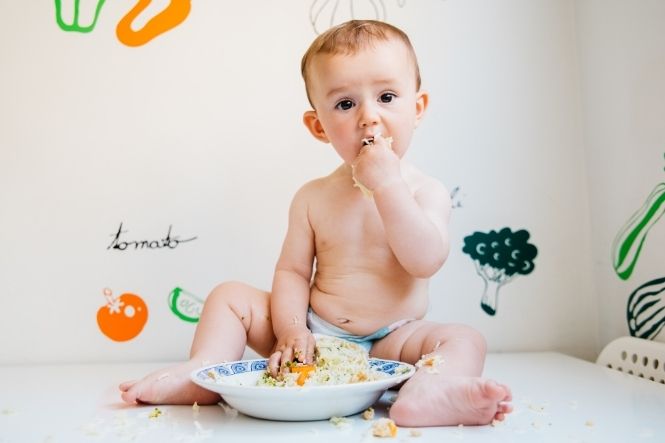Baby-led weaning means that your baby is in charge of how they are eating and feeding themselves. This means that you don’t need to make specific meals for your baby but instead make filling meals that have your babies a portion size and ability to eat in mind. Starting with soft fruits and baked or steamed vegetables can help ease your baby into solid foods.
The most important thing about learning to do baby-led weaning is the safety of your baby. You want to gather as much information as you can about what foods are safe, what age to start at, and what kind of Developmental signs your baby will have to show before you can start doing this baby-led weaning. You’ll also want to ensure your doctor is in the loop.
You’ll have to develop a plan of what your goals are and the schedule that you want to stick to. It’s essential to ease your baby into this waiting process so that you can make any adjustments as you go along. You may have to start pre-loading the spoon for them and then handing it to your infant, but they may eat with their hands.
Table of Contents
What is Baby Led Weaning?
Baby-led weaning allows babies to learn how to feed themselves. This usually starts with pureed food and then progresses to different stages of pre-made baby foods before actually getting two solids. It’s about putting a baby in charge of mealtime instead of parents needing to spoon-feed the whole time. You’ll have to wait until your baby is strong enough to eat on their own, however.
Baby-led weaning is all about parents and caregivers following their baby’s needs. You have to watch for developmental Readiness to ensure that your baby is grown enough to feed themselves. It also means that you can cook a meal for the whole family with some modifications so that your baby can eat part of the family meal.
However, this doesn’t mean that you can order a piece of pizza and give one to your baby. You’ll be incorporating your baby as part of your family during mealtime from the get-go, which means allowing your baby to eat some of the same foods as the rest of the family but being mindful of smaller portions and making it easier safer for them to eat it.
The Benefits of Baby Led Weaning
The greatest benefits of baby-led weaning are that your baby is going to experience viable social skills. It incorporates the idea of family at Meal Time and interest if they feel like part of the collective instead of meeting to set off on their own. It can also save time and money because you aren’t prepping food specifically for your baby.
Some of the advantages of baby-led weaning are:
- Saving money and time: you’re going to be cutting down on meal prep time because everyone is eating somewhere things, but you also save money from not being too by specific baby foods.
- Your baby gets social interactions: your baby will be eating with the whole family, which helps give positive social and developmental reinforcements. Your baby will be able to see role models on how to chew and swallow.
- Your baby gets exposed to diverse food: pre-made baby food has soft textures and tends to have similar Foods. However, if you incorporate your baby’s eating needs into the family meal, they’re going to experience many different foods with different tastes and textures.
- Your infant can gauge their own developmental skills: letting your baby control their eating means that they can measure their appetite and when they are hungry or full. It’s about teaching them self-regulation, so they don’t over or under-eat because they control what they’re eating and swallowing.
Eating for themselves is an excellent way for them to practice fine motor skills and experience what it’s like to eat as a full adult. Giving them a chance to watch other people eat will help them learn about the best tactics and allow them to experience different foods in the social aspects of family meals.
How to Do Baby Led Weaning at 5 Months
You should wait until your infant is about five months old before you start getting into baby-led weaning. This gives them enough time to handle solid and has more motor skills to hold a spoon to bring it to their mouth. It also ensures that they can sit upright, which will make it safer for them to be eating solids.
Some of the best practices to start getting into baby LED weaning are
- Continuing with bottle-feeding or nursing: continue to bottle feed or nurse at a similar frequency to what you have already been doing since the beginning most of their nutrition is going to be coming from the breastmilk or formula. What they eat during family meals is more of an added treat to their meal.
- Forget about having a feeding schedule: having a feeding schedule for bottle-feeding or nursing can help you regulate how much your baby is eating, but with weaning, you should simply offer solid foods at mealtimes when your family is eating and let your baby decide whether or not they want to eat what you offer them.
- Stick to soft foods: Try to incorporate foods into your family meals that are soft enough that you can wash them with your fingers or are easily dissolvable. These are signs that your baby will easily gum and chew on whatever foods you’re offering.
- Find foods that are easy to grasp: you want to find foods that are easy for your baby to either hold in their hands or scoop up with their fingers so that they can eat the food even if they’re still figuring out how to use spoons.
- Make it a family meal: you want your baby to feel as if they are part of whatever family meal is happening. That means keeping them as close to the dining table as possible and offering them foods that the other family members are eating. This also means having your family’s it together for meals and not sitting at a TV or scattered throughout the house.
- Offer a variety of different foods Cohen you want to expose your child to a variety of other choices so that they can decide what they like and what they don’t. Offer foods that have different colors and textures to try out add a variety of other things. You may find that your child is drawn to one food more than another, but you must continue to offer variety.
Remember to keep an eye on your baby as they start to eat so that you can ensure that there aren’t any choking hazards or other issues while they’re eating. It’s also essential to avoid anything that could cause an allergic reaction, as you don’t want to incorporate allergens into your baby’s diet just yet. Stick to safe foods and ensure they’re eating correctly.
Conclusion
The most important part about getting into baby-led weaning is to keep in mind your child’s safety. This means sticking to soft and easy foods for them to handle so that they can slowly get used to feeding themselves. Don’t be afraid to slowly incorporate more solid foods as you want to offer food to your infant and let them decide if they want it.






